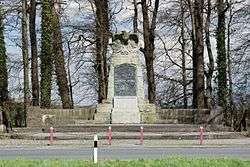Battle of Villinghausen
| Battle of Villinghausen | |||||||
|---|---|---|---|---|---|---|---|
| Part of the Seven Years' War | |||||||
 Bataille de Willinghausen, print, Frankfurt 1789 | |||||||
| |||||||
| Belligerents | |||||||
|
|
| ||||||
| Commanders and leaders | |||||||
| Duke Ferdinand of Brunswick |
Duc de Broglie Prince de Soubise | ||||||
| Strength | |||||||
| ~65,000 | ~90,000 | ||||||
| Casualties and losses | |||||||
| 1,400 | 5,000 (Broglie 4,700, Soubise 300) | ||||||
The Battle of Villinghausen (or Vellinghausen) was a battle in the Seven Years' War fought on the 15th and 16th of July, 1761, between a large French army and a combined Prussian-Hanoverian-British force led by Prince Ferdinand of Brunswick.
Background
Two French armies, under two Marshals, Duc de Broglie and Prince de Soubise met up in July 1761, intending to force Prince Ferdinand out of Lippstadt, an important town. Allied reinforcements under General Spörcken arrived bringing Ferdinand's forces up to 65,000 while the combined French armies numbered around 90,000.[1]
Battle
The allied Prussian-Hanoverian-British forces lined up along a series of hills, with their left anchored by the Lippe River (in the north), and the Ahse River in their centre. The French army advanced on 15 July, and Broglie's troops in the north made progress against German troops under Wutginau. However, British troops under Granby just south of Wutginau held their ground and the French assault stalled. Reinforcements for both sides arrived that night and Ferdinand strengthened his left at the expense of his right.
The next morning, Broglie continued his attack on the Allied left, expecting Soubise to attack the weakened Allied right. However, Soubise only ordered a few small actions against the right, due in part that both French commanders were the same rank and reluctant to take orders from the other. Allied reinforcements under Wolff soon arrived along the Lippe River and attacked the French flank, halting Broglie's attack and forcing his men to withdraw. By about noon, the French were in full retreat and the battle was over.
Aftermath

News of the battle provoked euphoria in Britain, and led William Pitt to take a much tougher line in the ongoing peace negotiations with France.[2] Despite the defeat the French still had a significant superiority in numbers and continued their offensive, although the two armies split again and operated independently. Despite further attempts to push an offensive strategy in Germany, the French were pushed back and finished the war in 1762 having lost the strategic post of Cassel. The Treaty of Paris led France to evacuate the remaining German territory it had occupied during the war.
Other notable officers and regiments
- Lieutenant General John Manners, Marquess of Granby, 21st Regiment of (Light) Dragoons (Royal Forresters)
- Lieutenant-Colonel (brevet) Charles Cornwallis, 2nd Earl Cornwallis (later 1st Marquess Cornwallis), 12th Regiment of Foot
- Major General George Townshend, 4th Viscount Townshend (later 1st Marquess Townshend), possibly the 24th Regiment of Foot
- Pierre-François, Marquess of Rougé, lieutenant-general, who died in action at this Battle, such as his cousin the Duke of Croÿ-Havré
See also
References
Bibliography
- Szabo, Franz A.J. The Seven Years War in Europe, 1757-1763. Pearson, 2008.
Sources
Coordinates: 51°39′44″N 7°59′43″E / 51.66222°N 7.99528°E